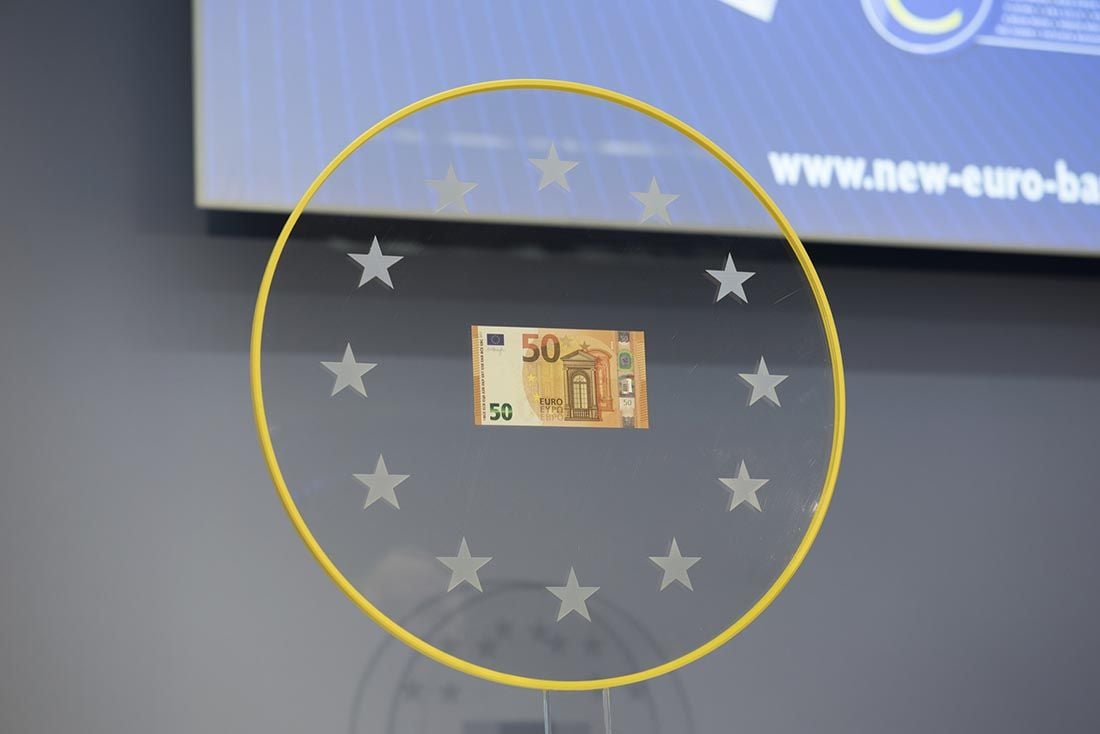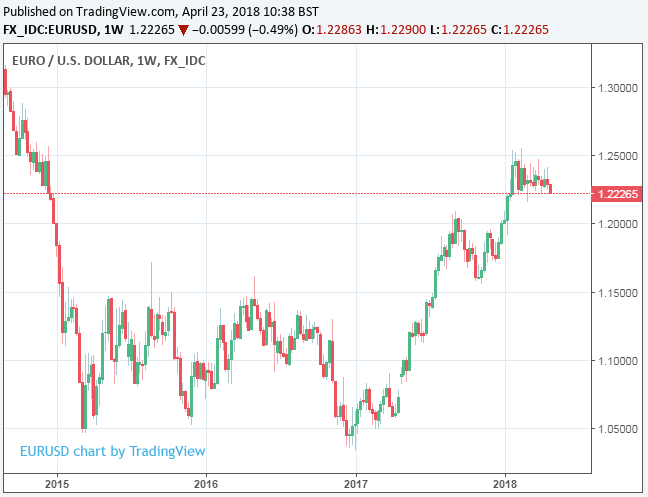Euro Dips as Manufacturing Growth Reaches 17-month Low; BofAML say Sell EUR/USD
- Written by: James Skinner
- Eurozone manufacturing growth slows further during April.
- Strong Euro and capacity constraints bite ahead of ECB meeting.
- Strategists turn bearish on the Euro, BofAML says "Sell".

© European Central Bank
The Euro slipped during early trading Monday after surveys showed activity in the Eurozone's key manufacturing industry slowing by a touch during the April month, adding further weight to concerns about the loss of economic momentum in the currency bloc.
April's IHS Markit manufacturing PMI fell to 56.0, down from 56.6 in March, when markets had been looking for it to hold steady during the current month. This marks a 17 month low and fourth consecutive fall for the index.
The IHS Markit services PMI surprised markets when it rose by a fraction from 54.9 to 55.0, when it had been expected to fall 10 basis points to 54.8. However, this was overshadowed by the negative result of the manufacturing survey, which is more significant for markets given the relative size of Europe's manufacturing industry and its importance for exports.
"Eurozone business activity continued to rise at a solid pace in April, though the rate of expansion remained considerably weaker than seen earlier in the year amid signs of weaker growth of demand and supply constraints," says IHS Markit, in a statement.
Slower inflows of new orders and weaker optimism about the business outlook means manufacturing growth could slow further one into May, IHS Markit warns, after new orders slowed to their weakest pace in 15 months.
Capacity constraints have been a noteworthy contributor to the slowdown after close to 18 months of solid gains for Eurozone industry left the bloc's factories struggling to keep pace with demand.
This earlier growth coincided with a broad-based global economic upturn that now also appears to be waning, with almost all developed world economies now on track for a first quarter slowdown.
"In manufacturing the main constraints on momentum are two-fold; first, a stronger euro is beginning to hit new orders growth, at the margin, especially relative to U.S. competitors," says Claus Vistesen, chief Eurozone economist at Pantheon Macroeconomics. "Second, supply-side bottlenecks and shortage of skilled staff—especially in Germany—are a challenge. Overall, though, the headline manufacturing index still signals robust growth in industrial production."
The Euro was quoted lower against the US Dollar, Pound, Swiss Franc, Canadian Dollar and New Zealand Dollar following the releases. The Euro-to-Dollar rate was down 0.30% at 1.2248 while the Euro-to-Pound exchange rate was 0.23% lower at 0.8750.

Above: Euro-to-Dollar rate shown at daily intervals.
Vistesen makes an important point that, while often overlooked, shouldn't really surprise anybody: The Euro has risen by around 15% against the US Dollar and by nearly 10% on a trade weighted basis during the last 12 months. Meanwhile, the US Dollar index has dropped by 10% and the White House has implemented a record package of tax cuts and reforms.
This means manufactured goods produced in the Eurozone are less competitive than they were just one year ago while exporters in the US, a key competitor of the Eurozone, have not only benefitted from a double digit currency devaluation but also from competitiveness-enhancing tax cuts.
It is not yet clear how much these factors will weigh on Eurozone activity going forward but they could have severe implications for the Euro if European Central Bank policymakers are forced into making further comments on the currency after this week's policy meeting, which concludes with a press conference on Thursday.
There have been signs recently that ECB rate setters could soon become more proactive in attempting to talk-down the Euro during the months ahead.

Above: Euro-to-Dollar rate shown at weekly intervals.
"EUR/USD sold off in its range on Friday and hit our take profit/near term target. It has eroded the 1.2272 2017-2018 uptrend, which is regarded as negative. But we suspect that in order to really generate some downside interest that we will need to see a close below the 1.2215 April low and the 1.2155 February low," says Karen Jones, head of technical analysis at Commerzbank.
Jones writes in her daily briefing the Euro-to-Dollar rate will remain "capped" at an important technical level that coincides with the 1.2420 area and so long as the exchange rate is below this threshold it will remain vulnerable to further losses.
The EUR/USD rate dropped 0.53% last week and is unchanged over the last three months after having stalled its advance in the middle of February. Some are now suggesting it is a good idea to bet against the exchange rate.
"We recommend selling EURUSD spot at 1.2378, target 1.15, stop loss 1.26," says Athanasios Vamvakidis, an FX strategist at Bank of America Merrill Lynch. "Data, rate differentials and our central bank calls are supportive. Market is short USD. We expect recent trade tensions to ease. We expect US profit repatriation. Quant and technicals supportive. Risks: US policy uncertainty, global move towards trade protection, recent geopolitics in Syria."
Much of the Euro's gains over the last year have been driven by previously-rising growth momentum and mounting expectations the ECB will soon call an end to the quantitative easing program that, in recent years, forced Eurozone bond yields into negative territory and drove international capital out of the Eurozone.
The ECB said in December it will continue buying €30 billion of European bonds each month until “September 2018 or beyond”, with the final stoppage subject to developments around inflation. Until December 2017 it had been buying €60 billion or more each month in an effort to stoke consumer price pressures by spurring economic activity.
Markets are now looking for the bank to "taper" its monthly bond purchases to zero between September and December but the minutes of its latest policy meeting suggest ECB President Mario Draghi may adopt adopt a tougher line on the Euro this Thursday, potentially using language designed to push it lower against the US Dollar and other major currencies.
Advertisement
Get up to 5% more foreign exchange by using a specialist provider to get closer to the real market rate and avoid the gaping spreads charged by your bank when providing currency. Learn more here.




